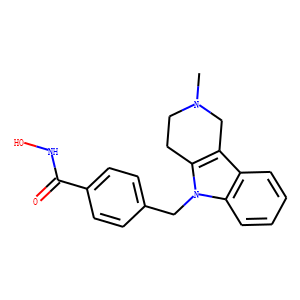| Reference | 1. J Trauma Acute Care Surg. 2017 Nov 21. doi: 10.1097/TA.0000000000001753. [Epub
ahead of print] <br />
Tubastatin A Prevents Hemorrhage-Induced Endothelial Barrier Dysfunction. <br />
Bruhn PJ(1)(2), Nikolian VC(1), Halaweish I(1), Chang Z(1), Sillesen M, Liu B(1),
Li Y(1), Alam HB(1). <br />
Author information: <br />
(1)Department of Surgery, University of Michigan, Ann Arbor, Michigan.
(2)Department of Surgical Gastroenterology, Rigshospitalet, University of
Copenhagen Hospital, Copenhagen, Denmark. <br />
BACKGROUND: Microvascular hyperpermeability resulting from endothelial barrier
dysfunction (EBD) is associated with worse clinical outcomes in trauma-induced
hemorrhagic shock. We have previously shown that treatment with Tubastatin A
(TubA), a histone deacetylase 6 inhibitor, improves outcomes in animal models of
shock. In this study, we investigate whether TubA treatment may prevent
trauma-related EBD.<br />
METHODS: Wistar-Kyoto rats subjected to 40% hemorrhage were treated with TubA or
vehicle control. Acute lung injury (ALI) was assessed histologically from tissues
harvested 6 hours post-hemorrhage. In vitro, human umbilical vein endothelial
cells (HUVECs) were cultured in EGM BulletKit medium. Medium was exchanged for
glucose-free Dulbecco/’s Modified Eagle Medium (0.5% fetal bovine serum) with or
without TubA, and cells were placed in an anoxic chamber (5% CO2, 95% N2, 20-48
hours). Expression of acetylated tubulin and hypoxia-inducible factor 1α (HIF-1α)
were measured by Western blot. Soluble Intercellular Adhesion Molecule-1
concentration within the medium, a marker of endothelial integrity, was
determined using enzyme-linked immunosorbent assay. Monolayers were assessed for
permeability via transwell assays using fluorescein isothiocyanate-labeled
albumin.<br />
RESULTS: Rats treated with TubA had significantly reduced ALI relative to vehicle
control. In vitro, TubA significantly attenuated anoxia-induced
hyperpermeability, HIF-1α expression, and glycocalyx shedding.
CONCLUSIONS: Our findings demonstrate that TubA prevents hemorrhage-induced ALI
in rats. Additionally, we have shown that TubA prevents anoxia-induced EBD in
vitro. Taken together, these results suggest that TubA could attenuate
microvascular hyperpermeability related to hemorrhagic shock.
LEVEL OF EVIDENCE: n/a (pre-clincal study) STUDY TYPE: Pre-clinical. <br />
2. J Alzheimers Dis. 2014;41(4):1193-205. doi: 10.3233/JAD-140066. <br />
Tubastatin A/ACY-1215 improves cognition in Alzheimer/’s disease transgenic mice. <br />
Zhang L(1), Liu C(1), Wu J(1), Tao JJ(1), Sui XL(1), Yao ZG(1), Xu YF(1), Huang
L(1), Zhu H(1), Sheng SL(1), Qin C(1). <br />
Author information: <br />
(1)Comparative Medical Center, Peking Union Medical College (PUMC) & Institute of
Laboratory Animal Science, Chinese Academy of Medical Science (CAMS), Beijing,
China. <br />
Histone deacetylase 6 (HDAC6) is currently being discussed as a promising
therapeutic target for the treatment of Alzheimer/’s disease (AD). Mounting
evidence indicates that increased HDAC6 expression may contribute to
AD-associated neurodegeneration, although beneficial effects have also been
identified. In the present study, we tested the potential of two selective HDAC6
inhibitors, tubastatin A and ACY-1215, to rescue cognitive deficits in a mouse
model of AD. We found that both tubastatin A and ACY-1215 alleviated behavioral
deficits, altered amyloid-β (Aβ) load, and reduced tau hyperphosphorylation in AD
mice without obvious adverse effects. Our data suggested that tubastatin A and
ACY-1215 not only promoted tubulin acetylation, but also reduced production and
facilitated autophagic clearance of Aβ and hyperphosphorylated tau. Further, the
decreased hyperphosphorylated tau and increased tubulin acetylation may account
for the improved microtubule stability in AD mice after tubastatin A/ACY-1215
treatment. These preclinical results support the detrimental role of HDAC6 in AD,
and offer prospective approaches for using tubastatin A/ACY-1215 as potential
therapeutic strategy for AD. <br />
3. J Am Chem Soc. 2010 Aug 11;132(31):10842-6. doi: 10.1021/ja102758v. <br />
Rational design and simple chemistry yield a superior, neuroprotective HDAC6
inhibitor, tubastatin A. <br />
Butler KV(1), Kalin J, Brochier C, Vistoli G, Langley B, Kozikowski AP. <br />
Author information: <br />
(1)Drug Discovery Program, Department of Medicinal Chemistry and Pharmacognosy,
University of Illinois at Chicago, 833 South Wood, Chicago, Illinois 60612, USA. <br />
Structure-based drug design combined with homology modeling techniques were used
to develop potent inhibitors of HDAC6 that display superior selectivity for the
HDAC6 isozyme compared to other inhibitors. These inhibitors can be assembled in
a few synthetic steps, and thus are readily scaled up for in vivo studies. An
optimized compound from this series, designated Tubastatin A, was tested in
primary cortical neuron cultures in which it was found to induce elevated levels
of acetylated alpha-tubulin, but not histone, consistent with its HDAC6
selectivity. Tubastatin A also conferred dose-dependent protection in primary
cortical neuron cultures against glutathione depletion-induced oxidative stress.
Importantly, when given alone at all concentrations tested, this
hydroxamate-containing HDAC6-selective compound displayed no neuronal toxicity,
thus, forecasting the potential application of this agent and its analogues to
neurodegenerative conditions. <br />
|

